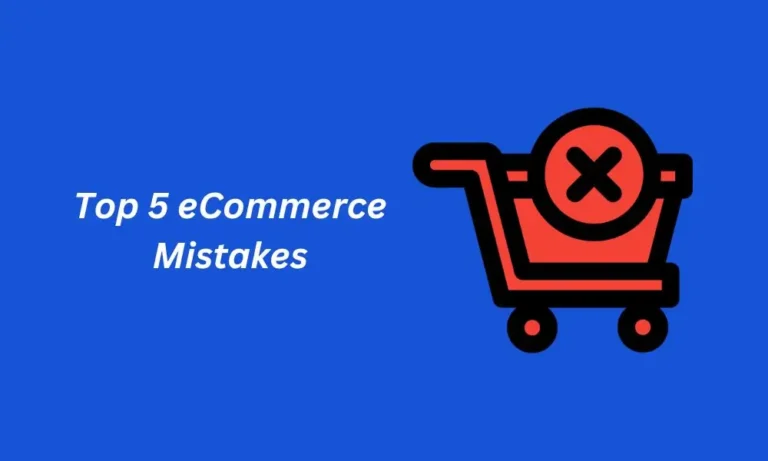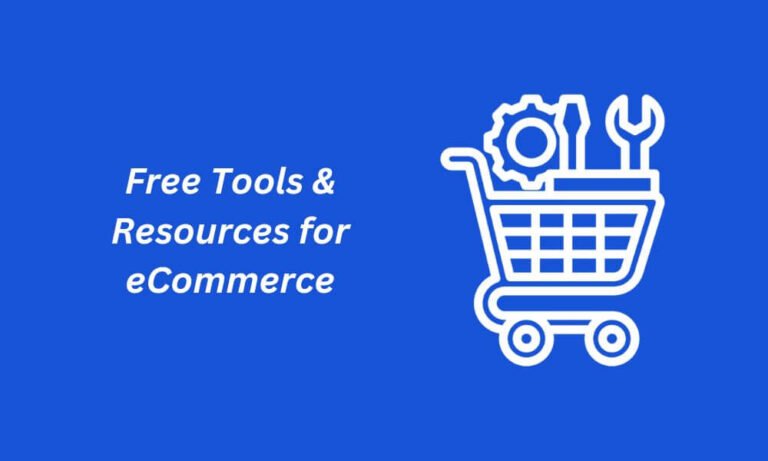In this blog post, you’ll learn how to build an online store the right way. If this is of interest to you, then keep reading!
Introduction
Starting an eCommerce business is an exciting journey filled with opportunities for growth and success. In today’s digital age, having an online store is essential for reaching a broader audience and increasing sales.
But building a successful eCommerce website goes beyond just listing products. You need a functional, visually appealing, and customer-friendly store that encourages visitors to make purchases.
In this guide, I’ll walk you through the entire process of how you can build an online store from choosing the right platform to optimizing your product listings.
Whether you’re a beginner or an experienced entrepreneur looking to improve your current store, this step-by-step guide will help you create a website that converts visitors into loyal customers.
Table of Contents
How to Build an Online Store That Converts

Now let’s get started with the step-by-step guide on how to build an online store that converts. Here are all need to get started as a beginner.
Step 1: Choose the Right eCommerce Platform
The first step in building your online store is choosing the platform that will serve as the foundation of your business.
There are many eCommerce platforms available, each offering different features, pricing models, and levels of customization. Your choice will depend on your business needs, technical skills, and long-term goals.
Shopify: A User-Friendly Option
If you’re new to eCommerce or looking for a solution that is easy to set up and maintain, Shopify is a great choice. It offers a comprehensive suite of tools designed to help you manage everything from product listings to inventory, shipping, and customer relationships.
Shopify also provides a wide range of mobile-friendly themes that can be easily customized to match your brand’s identity.
One of Shopify’s strengths is its user-friendly interface and built-in tools, making it simple to set up a store even if you don’t have coding experience.
Additionally, Shopify offers a variety of apps and plugins to enhance your store’s functionality, whether you need advanced analytics, marketing automation, or customer support features.
WooCommerce: Customization Flexibility
If you prefer greater control over your website’s design and functionality, WooCommerce might be the better option. WooCommerce is a plugin for WordPress, which means it integrates seamlessly with WordPress websites and offers endless customization options.
If you’re already familiar with WordPress or have experience with web development, WooCommerce can provide the flexibility you need to create a unique shopping experience for your customers.
Unlike Shopify, WooCommerce is free to use, although you may incur additional costs for web hosting, premium themes, and plugins. It’s an excellent option for entrepreneurs who want to build a custom online store while keeping costs manageable.
Other Platforms to Consider
- BigCommerce: Known for its scalability, BigCommerce is ideal for businesses that are expecting rapid growth or high transaction volumes.
- Magento: A highly customizable and robust platform, Magento is better suited for larger enterprises with complex needs and access to a dedicated development team.
- Squarespace: Best for small businesses, Squarespace offers sleek designs and an easy-to-use interface, but it’s more limited in terms of features compared to Shopify and WooCommerce.
Step 2: Design Your Store with User Experience in Mind
A well-designed store is essential for engaging visitors and making it easy for them to find what they need. When designing your website, focus on simplicity, clarity, and a seamless user experience (UX). A well-designed store can make a significant difference in converting visitors into buyers.
Keep It Clean and Simple
A clean and simple design is key to keeping visitors focused on your products. Overwhelming them with too much information or a cluttered design can lead to higher bounce rates and lower conversion rates.
Choose a theme that is minimalistic and easy to navigate. Many eCommerce platforms, like Shopify and WooCommerce, offer professionally designed themes that cater to different industries and aesthetic preferences.
Pay attention to the following design elements:
- Navigation: Ensure your navigation menu is clear and organized. Categories should be easy to find, and product filters (by price, size, color, etc.) should be available to help customers browse more efficiently.
- Search Functionality: Include a search bar at the top of your page to allow customers to quickly locate specific products.
- Mobile Responsiveness: Ensure that your store is mobile-friendly, as a significant portion of online shopping happens on smartphones and tablets.
- Checkout Process: Keep your checkout process simple and streamlined. A long or confusing checkout can lead to cart abandonment. Consider offering a guest checkout option, multiple payment methods, and clear calls-to-action (CTAs) throughout the process.
Use High-Quality Images
Visuals are one of the most important elements of any online store. High-quality images that showcase your products from multiple angles will help build trust with potential buyers. Customers can’t physically touch your products, so they rely on images to make purchasing decisions.
Invest in professional product photography or use high-resolution images that show off the details of your items.
- Use Multiple Views: Display products from different angles, and if possible, include zoom-in functionality so customers can see intricate details.
- Consistency: Ensure that all product images are consistent in terms of style, lighting, and background to create a cohesive visual experience.
Step 3: Optimize Product Listings for Higher Conversions
Once your store design is ready, it’s time to optimize your product listings. A well-crafted product listing can make a significant difference in whether or not a customer decides to buy from you.
Here are a few ways to optimize your product pages for maximum conversion.
Create Engaging Product Descriptions
Your product descriptions should do more than simply list features; they should engage the customer and explain how your product solves a problem or meets their needs.
Use clear, concise language and focus on the benefits of the product rather than just the technical details.
- Highlight Key Features: Focus on the most important features that your customers care about, such as quality, functionality, and style.
- Use Bullet Points: Break down features into bullet points to make them easy to read.
- Include a Call-to-Action (CTA): Encourage customers to take the next step with phrases like “Buy Now,” “Add to Cart,” or “Limited Stock Available.”
Use SEO-Friendly Titles and Descriptions
Optimizing your product titles and descriptions for search engines (SEO) is essential for driving organic traffic to your website.
Use relevant keywords that potential customers are likely to search for when looking for products like yours.
- Product Titles: Include the main keyword in your product title while keeping it descriptive. For example, instead of “Black Shirt,” use “Men’s Black Casual Shirt – Slim Fit.”
- Meta Descriptions: Write a compelling meta description for each product page to help improve its search engine ranking and encourage click-throughs.
Include Product Reviews
Product reviews are a powerful tool for building trust with new customers. According to research, 88% of consumers trust online reviews as much as personal recommendations.
Encourage your customers to leave reviews by sending follow-up emails after a purchase or offering a small incentive, such as a discount on their next order.
Step 4: Add Essential Pages to Your Website
In addition to your product listings and checkout page, there are several other essential pages that every eCommerce website should include.
These pages build trust with your customers by providing valuable information about your brand, policies, and how to get in touch with you.
About Us Page
Your “About Us” page is an opportunity to tell your brand’s story and connect with your audience on a personal level. Share your company’s mission, vision, and values.
Let customers know why you started your business and what makes your products special. The more relatable and authentic your brand feels, the more likely customers are to trust and buy from you.
Contact Page
Make it easy for customers to reach you with a dedicated contact page. Include a contact form, email address, phone number, and links to your social media accounts.
Providing multiple ways to contact you gives customers confidence that they can get help if they need it.
FAQ Page
A “Frequently Asked Questions” (FAQ) page can help address common questions or concerns that customers may have before making a purchase. Include information on shipping times, return policies, product care instructions, and more.
A well-crafted FAQ page can reduce the number of customer inquiries and improve the overall shopping experience.
Privacy Policy and Terms & Conditions
These legal pages are essential for protecting your business and customers. The privacy policy should outline how you collect, store, and use customer data, while the terms and conditions page should cover the rules of using your website and making purchases.
Step 5: Test and Launch Your Store
Before launching your store, take the time to thoroughly test every aspect of it. Make sure the navigation is smooth, product pages load quickly, and the checkout process works without any issues. Invite friends or family to browse your site and provide feedback.
- Test on Multiple Devices: Ensure your website looks and functions well on desktops, tablets, and mobile phones.
- Check for Broken Links: Use online tools to scan for broken links or errors on your site that could affect user experience.
- Review SEO Settings: Double-check your SEO settings to make sure your titles, meta descriptions, and product pages are optimized for search engines.
Once you’ve completed your testing, it’s time to launch your store. Spread the word through social media, email marketing, and collaborations with influencers to drive traffic to your site.
Conclusion
Building an online store is an exciting process that can lead to significant growth for your business. By choosing the right platform, designing your store with user experience in mind, optimizing product listings, and including essential pages, you can create a website that not only looks great but also converts visitors into loyal customers.
Remember, the key to success in eCommerce is constant improvement. After launching your store, continue to gather feedback, monitor your performance, and make adjustments to improve your customer experience. With the right approach, your online store can become a profitable and sustainable business.
Frequently Asked Questions
What is the best platform to use for building an online store?
The best platform depends on your needs and technical expertise. For beginners, Shopify is a great choice due to its ease of use and comprehensive features. WooCommerce is ideal if you’re familiar with WordPress and want greater customization options. Other platforms to consider include BigCommerce, Magento, and Squarespace.
How can I ensure my online store is mobile-friendly?
Most eCommerce platforms offer mobile-responsive themes. When choosing a theme, ensure it adjusts well on smartphones and tablets. You should also test your site on multiple devices before launching to ensure the design, navigation, and checkout process work seamlessly on mobile.
What are the essential pages every online store should have?
In addition to product pages and a checkout page, your store should include an “About Us” page to share your brand story, a “Contact” page with ways for customers to reach you, an FAQ page, and legal pages such as a “Privacy Policy” and “Terms & Conditions.”
How can I optimize my product listings for better conversions?
To optimize product listings, create engaging product descriptions that highlight the benefits of your products. Use high-quality images showing multiple views, and include relevant keywords in product titles and descriptions to improve SEO. Offering customer reviews on product pages also builds trust and increases conversion rates.
What design elements should I focus on when building my online store?
Focus on simplicity and user experience. Ensure your navigation is intuitive, product categories are easy to find, and the checkout process is straightforward. A clean, clutter-free design with high-quality images can significantly enhance the customer experience and reduce cart abandonment.
How do I drive traffic to my online store after launching?
To drive traffic, promote your store through social media, email marketing, and collaborations with influencers. You can also leverage SEO strategies, such as optimizing product titles and descriptions for search engines, to attract organic traffic. Consider running paid ads on platforms like Google and Facebook to reach a wider audience.




